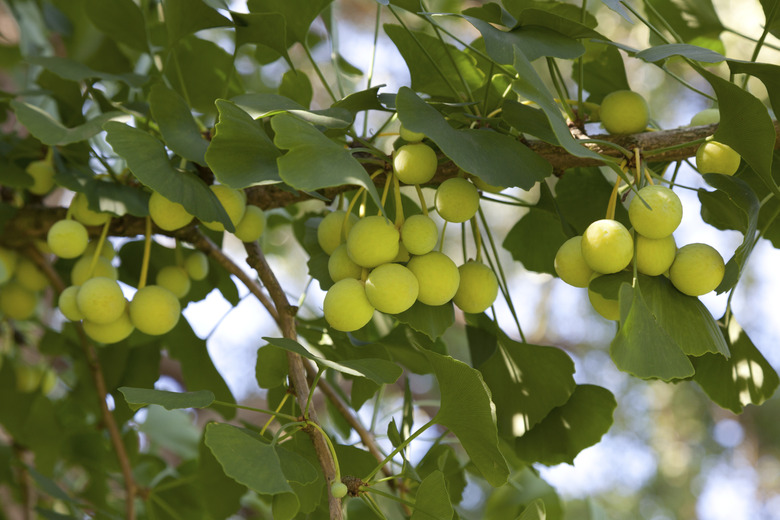Why Do Ginkgo Tree Berries Stink?
They look like berries, but they aren't. Those round things hanging in female ginkgo trees (Ginkgo biloba) are seeds with a fleshy covering, and, yes — they smell awful as they ripen. Some compare the odor to vomit and some to rancid butter. That's due to the **butyric acid** found in the seeds.
Step 1
Ginkgoes are an ancient species of tree, and fossil records establish their presence on earth at the time of the dinosaurs some 300 million years ago. Tall and resilient, practically pest-free and pollution tolerant, they are also very beautiful, with green fan-shaped leaves that turn bright yellow in autumn. They thrive in U.S. Department of Agriculture plant hardiness zones 3 through 8a. These popular garden and street trees bear very smelly seeds.
Naked Seeds
Step 1
The ginkgo tree is a gymnosperm, which means "naked seed" in Greek. The seeds do not grow enclosed in fruit, like those of apples or plums. Those 1-inch-long balls you notice hanging on ginkgoes may look very much like a cluster of small plums or apricots, but they are naked seeds. Ginkgo seeds do not smell fruity either, and most gardeners find the odor extremely disagreeable as the fruits ripen.
Step 2
- Ginkgoes are an ancient species of tree, and fossil records establish their presence on earth at the time of the dinosaurs some 300 million years ago.
- Ginkgo seeds do not smell fruity either, and most gardeners find the odor extremely disagreeable as the fruits ripen.
Ginkgo Reproduction
Step 1
Ginkgo trees are dioecious, which means there are separate male and female trees. The male trees produce the pollen, while the female trees bear paired ovules on the very tips of the branches. Pollen is carried by the wind to female ovules. The outer coating of the ovule is called the integument, and this becomes the outer covering of the new seed as it develops. Each seed has an inner core that resembles a silvery nut and the outer covering formed from the integument.
Blame Butyric Acid
Step 1
The integument of the ginkgo ovule contains a chemical compound called butyric acid. As the integument evolves into the ginkgo seed and ripens, the butyic acid smell — like rancid butter — increases. Because one mature female ginkgo bears hundreds of seeds, the fleshy mass beneath the tree is sufficiently malodorous to make the garden unattractive. The smell increases as the seed covering rots beneath the tree. For this reason, most of the ginkgoes planted in this country are male cultivars, like "Autumn Gold" that thrives in USDA plant hardiness zones 3 through 8.
Step 2
- Ginkgo trees are dioecious, which means there are separate male and female trees.
- The outer coating of the ovule is called the integument, and this becomes the outer covering of the new seed as it develops.
